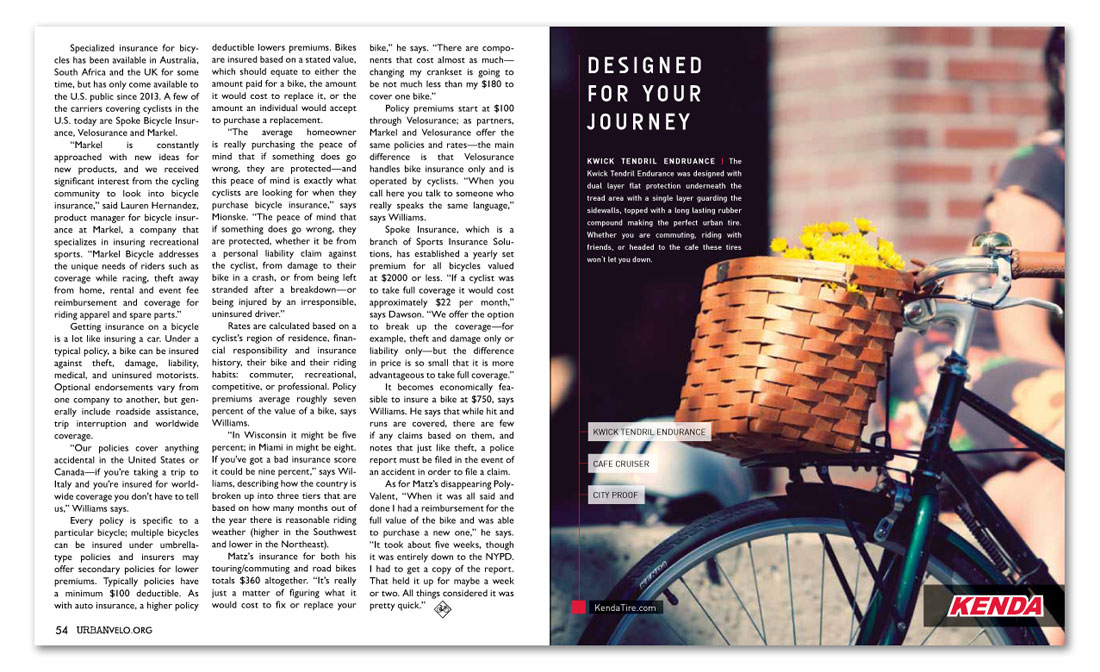


Specialized insurance for bicycles has been available in Australia, South Africa and the UK for some time, but has only come available to the U.S. public since 2013. A few of the carriers covering cyclists in the U.S. today are Spoke Bicycle Insurance, Velosurance and Markel.
“Markel is constantly approached with new ideas for new products, and we received significant interest from the cycling community to look into bicycle insurance,” said Lauren Hernandez, product manager for bicycle insurance at Markel, a company that specializes in insuring recreational sports. “Markel Bicycle addresses the unique needs of riders such as coverage while racing, theft away from home, rental and event fee reimbursement and coverage for riding apparel and spare parts.”
Getting insurance on a bicycle is a lot like insuring a car. Under a typical policy, a bike can be insured against theft, damage, liability, medical, and uninsured motorists. Optional endorsements vary from one company to another, but generally include roadside assistance, trip interruption and worldwide coverage.
“Our policies cover anything accidental in the United States or Canada—if you’re taking a trip to Italy and you’re insured for worldwide coverage you don’t have to tell us,” Williams says.
Every policy is specific to a particular bicycle; multiple bicycles can be insured under umbrella-type policies and insurers may offer secondary policies for lower premiums. Typically policies have a minimum $100 deductible. As with auto insurance, a higher policy deductible lowers premiums. Bikes are insured based on a stated value, which should equate to either the amount paid for a bike, the amount it would cost to replace it, or the amount an individual would accept to purchase a replacement.
“The average homeowner is really purchasing the peace of mind that if something does go wrong, they are protected—and this peace of mind is exactly what cyclists are looking for when they purchase bicycle insurance,” says Mionske. “The peace of mind that if something does go wrong, they are protected, whether it be from a personal liability claim against the cyclist, from damage to their bike in a crash, or from being left stranded after a breakdown—or being injured by an irresponsible, uninsured driver.”
Rates are calculated based on a cyclist’s region of residence, financial responsibility and insurance history, their bike and their riding habits: commuter, recreational, competitive, or professional. Policy premiums average roughly seven percent of the value of a bike, says Williams.
“In Wisconsin it might be five percent; in Miami in might be eight. If you’ve got a bad insurance score it could be nine percent,” says Williams, describing how the country is broken up into three tiers that are based on how many months out of the year there is reasonable riding weather (higher in the Southwest and lower in the Northeast).
Matz’s insurance for both his touring/commuting and road bikes totals $360 altogether. “It’s really just a matter of figuring what it would cost to fix or replace your bike,” he says. “There are components that cost almost as much—changing my crankset is going to be not much less than my $180 to cover one bike.”
Policy premiums start at $100 through Velosurance; as partners, Markel and Velosurance offer the same policies and rates—the main difference is that Velosurance handles bike insurance only and is operated by cyclists. “When you call here you talk to someone who really speaks the same language,” says Williams.
Spoke Insurance, which is a branch of Sports Insurance Solutions, has established a yearly set premium for all bicycles valued at $2000 or less. “If a cyclist was to take full coverage it would cost approximately $22 per month,” says Dawson. “We offer the option to break up the coverage—for example, theft and damage only or liability only—but the difference in price is so small that it is more advantageous to take full coverage.”
It becomes economically feasible to insure a bike at $750, says Williams. He says that while hit and runs are covered, there are few if any claims based on them, and notes that just like theft, a police report must be filed in the event of an accident in order to file a claim.
As for Matz’s disappearing PolyValent, “When it was all said and done I had a reimbursement for the full value of the bike and was able to purchase a new one,” he says. “It took about five weeks, though it was entirely down to the NYPD. I had to get a copy of the report. That held it up for maybe a week or two. All things considered it was pretty quick.”
Kenda